May 2019 – Volume 23, Number 1
| Publisher | Mondly |
| Product Type | Smart-device application software |
| Operating Systems | Android and iOS |
| Hardware Requirements | Smart-device (phone or tablet) and internet connection |
| Price | Free demo (full version available for $3.99/month) |
Introduction
Mobile-assisted language learning (MALL) can be defined as language learning supported by using mobile devices, such as smartphones, tablets, and other smart devices (Kukulska-Hulme, 2012), which encourages the experience of ‘ubiquitous learning’ (Yang, 2006) that mobile devices allow. MALL has been adopted for a wide audience, from young learners to adult learners, and more recently it has started being implemented for use with young learners. This is due to a number of factors, including an increased emphasis on the use of technology in education, increased availability of technology, and the ability for learning to occur anywhere and at any time.
The following review examines one example of MALL for young learners, Mondly for Kids. This app for smart devices claims to provide language learning in reading, writing, speaking, and listening for children in preschool through early grade school (PreK-3) using an interactive and colorful user interface. The app covers a multitude of topics, such as parts of the body, sports, and animals, and includes three types of exercises to teach 33 different languages. It should be noted that Mondly for Kids is intended for young learners with limited language proficiency (beginner or low-intermediate). For older or more proficient learners, it may be worthwhile to explore Mondly’s other app, Mondly Languages, also available for Android and iOS.
This review will begin with a description of Mondly for Kids including how to get started, the topics and lessons available, and the type of exercises included. It will then evaluate Mondly for Kids’ usefulness and pedagogical value for teaching languages to young learners.
Description
After downloading the app, first time users will be asked to input their native language, the language they would like to learn, and their grade level (either Preschool or School) (see Figure 1). Upon providing this information, the user will be prompted to try the full version for one week free. This one-week trial includes all 33 languages that Mondly for Kids currently offers. After this, users can select from different payment options to continue using the tool.

Figure 1. Setting up Mondly for Kids
There are eleven topics for each language, including parts of the body, sports, animals, and family (see Figure 2a for an example of these topics). Aside from the eleven topics that are available, the app also releases additional daily and weekly topics, such as monsters, items around the house, and musical instruments. Each topic includes seven lessons (see Figure 2b). The first six lessons focus on language learning through vocabulary and phrase repetition, and the seventh lesson focuses solely on vocabulary memorization, all of which are related to the topic. There is also a grayed-out activity button labeled “Conversation,” although it is unclear how to activate it.
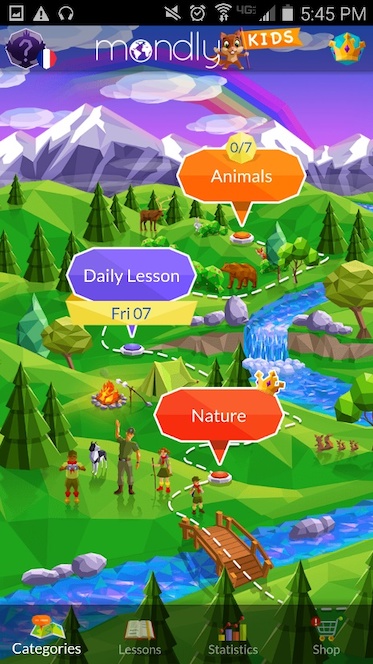 Figure 2a. Topic interface |
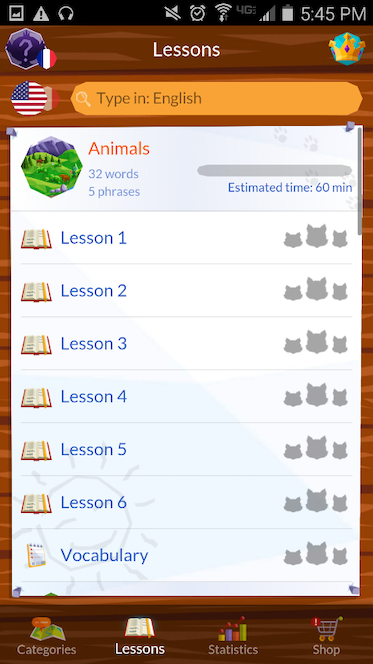 Figure 2b. Lesson interface |
Within each lesson, there are three types of activities. The first is matching the word with the correct picture. A word appears in the middle of two images and can be either in the user’s first language or the target language. If it appears in the user’s first language, the four selections available will be in the target language, or vice-versa. When the word appears, the app will play an audio file of the word being spoken aloud by either a native speaker or a machine-generated voice. If the user matches the word with the correct picture, the audio of the target word underneath is played (see Figure 3a). The second activity is also a matching activity in which the user swipes up or down towards the correct picture of the target word given in either the first language or the target language. Similarly, audio for the target word is played aloud, and if the user matches the word with the correct picture, audio of the correct word is also played aloud (see Figure 3b). Finally, the third activity type is creating phrases by ordering words correctly. The user is given a number of words and must translate either from the target language into the first language, or from the first language into the target language (see Figure 3c).
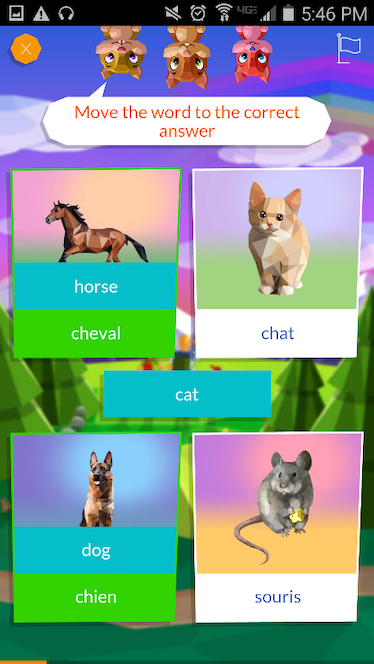 Figure 3a. Matching activity 1 |
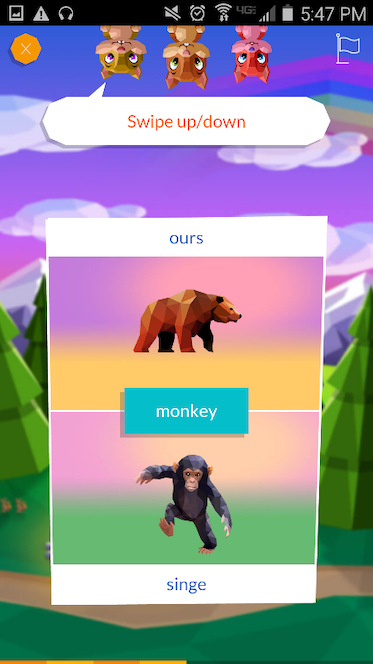 Figure 3b. Matching activity 2 |
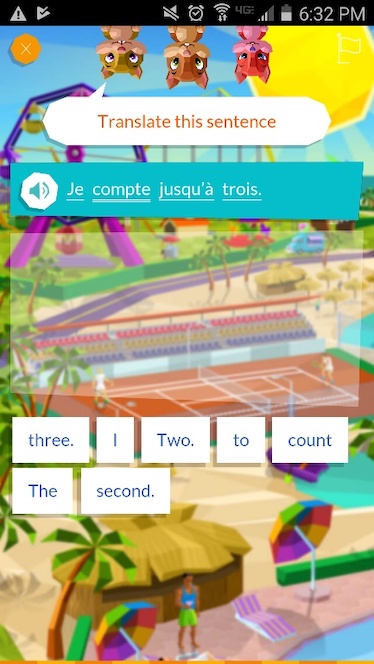 Figure 3c. Phrase creation activity |
There is also a review page after each exercise (see Figure 4), where extra information about verb and phrase construction is given for present, past, and future tenses. This page provides the vocabulary words again along with audio of the target words and phrase constructions. Also, if a verb is introduced in the lesson, there is a verb conjugation table provided.

Figure 4. Setting up Review page
In short, Mondly for Kids provides language instruction targeted at young learners using vocabulary building activities, translation activities, human-recorded or machine-generated audio, and review pages. By using this app, users are given an opportunity to develop a lexicon of nouns and some verbs in a target language.
Evaluation
Perhaps the most important element to keep in mind during the evaluation of this app is its intended audience, i.e., young learners. As such, the evaluation of this app will be two-fold: first, we will evaluate how effectively Mondly for Kids teaches languages to young learners, and second, we will evaluate the effectiveness of Mondly for Kids as a MALL tool.
As Shin (2006) suggests, when teaching languages to young learners, instructors should supplement activities with visuals and realia (objects from everyday life), have numerous short activities because children have short attention spans, and teach in themes. Mondly for Kids does an effective job with these three elements except for using realia, as this is nearly impossible to provide using MALL. The app is colorful and makes good use of visuals, is organized specific and understandable topics (e.g., nature, animals, etc.), and moves rather quickly between the different activity types. However, there are other features suggested by Shin (2006) which are not addressed by Mondly for Kids, such as teaching with tangible items, allowing students to create visuals and realia, and bringing in helpers from the community (e.g., native speakers of a target language). It may not be entirely feasible to incorporate all these features into a mobile app, thus it might be more appropriate to use this app as an additional tool to supplement language learning, but its use alone may not ensure effective language learning, according to the features outlined by Shin (2006).
Next, we will use the MALL framework created by Reinders and Pegrum (2016) to further examine the strengths and weaknesses of Mondly for Kids by evaluating it based on its educational affordances, general pedagogical design, second language pedagogical design, second language acquisition (SLA) design, and affective design. For educational affordances, the app does allow for plenty of local learning opportunities; that is, the app allows for the individual learner to be immersed in a contained, episodic, and static learning environment. This means that the user can learn the materials that the app developers release and not much else. There is no room for the user to interact with the language in an authentic or spontaneous manner. This is problematic because, in contrast to claims made by the app’s developers, Mondly for Kids does not provide training in all four skill areas—reading, writing, listening, and speaking. It revolves almost entirely around vocabulary training mixed with sparse listening training, even though listening skills are never assessed. Reading, writing, and speaking are not taught or evaluated by this app. Furthermore, the app does not provide much global or social learning within relevant cultural contexts or with native speakers beyond pre-recorded audio. There is no way for the user to interact with other speakers or texts in the target language.
Perhaps the more effective aspect of Mondly for Kids is its attention to affective design. The app is bright, colorful, and highly engaging. Young learners would be enticed by the visuals provided in each topic, as they are relevant and relatable to what a young learner would expect to see, making the connection between language and context more salient. The review panel allows students to interact with materials they have already learned, which is reassuring to the student that progress is being made. However, there are some opportunities for development within the app as well, such as providing more direction, structure, and instructions. Users can easily become lost or be unsure of how the app works (e.g., the “Conversation” button). These shortcomings can lead to frustration with the app as a learning tool because navigation becomes difficult.
As far as SLA and pedagogical designs used, the app is grounded in behaviorist learning, meaning that learning occurs primarily through repetition. Users will explore mostly the same vocabulary continuously throughout all seven lessons of a topic. As such, there are very few exercises that allow the student to construct meaningful phrases in the target language. More specific to second language pedagogy, Mondly for Kids does provide comprehensible input and output to young learners according to the Reinders and Pegrum (2016) framework and Shin (2012), although there are no opportunities for communicative learning, intercultural learning, or negotiation of meaning. The feedback provided by the app is essentially correct or incorrect with no explicit corrective feedback or the correct form or vocabulary. This could be detrimental to a young learner who cannot intuitively figure out their own mistake and correct it.
Conclusion
Mondly for Kids is an interactive and colorful app to teach languages to young learners. Relying heavily on behaviorist theories and repetition drills for listening comprehension and vocabulary building, the app provides little attention to writing, speaking, and reading. As a MALL tool, it could be useful for providing supplemental instruction in language learning environments but cannot stand alone as a tool for language learning. Yet there are many opportunities for the app’s developers to strengthen this language learning tool. If the app’s developers state that users can learn to read, write, speak, and listen in a target language, it makes sense to address these four skills within the app, which Mondly for Kids does not currently provide. Also, while appealing to a younger audience, there needs to be more focus on interacting with the language and users of the language. This could be accomplished by providing more interactive activities, or by providing opportunities to interact with speakers of the target language. Finally, including more structure and instructions would be ideal for users of all ages. However, as not many mobile apps exist with the explicit description to teach young learners second languages, this is certainly a field in which Mondly could lead the way.
References
Kukulska-Hulme, A. (2012). Mobile-assisted language learning. In C. Chapelle (Ed.), The encyclopedia of applied linguistics (pp. 3701-3709). New York, NY: Wiley Online Library.
Reinders, H., & Pegrum, M. (2016). Supporting language learning on the move: An evaluative framework for mobile language learning resources. In B. Tomlinson (Ed.), Research and materials development for language learning (pp. 219-232). New York, NY: Routledge.
Shin, J. K. (2006). Ten helpful ideas for teaching English to young learners. English Teaching Forum, 44(2), 2-13.
Yang, S. J. H. (2006). Context aware ubiquitous learning environments for peer to peer collaborative learning. Educational Technology and Society, 9, 188-201.
About the Reviewer
Timothy Kochem is a PhD student in the Applied Linguistics & Technology program at Iowa State University. His research interests include L2 pronunciation pedagogy, distance education, language teacher development, and educational technology.
<tkochem![]() iastate.edu>
iastate.edu>
| © Copyright rests with authors. Please cite TESL-EJ appropriately.Editor’s Note: The HTML version contains no page numbers. Please use the PDF version of this article for citations. |

